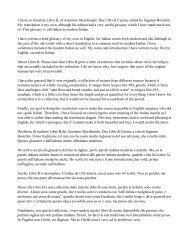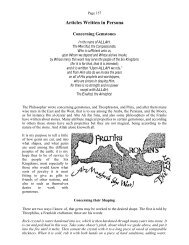How to Milk an Almond Stuff an Egg And Armor a Turnip A ...
How to Milk an Almond Stuff an Egg And Armor a Turnip A ...
How to Milk an Almond Stuff an Egg And Armor a Turnip A ...
You also want an ePaper? Increase the reach of your titles
YUMPU automatically turns print PDFs into web optimized ePapers that Google loves.
150<br />
To Make a Feast<br />
The first step in pl<strong>an</strong>ning a feast, even before choosing recipes, is <strong>to</strong> make a rough estimate of<br />
the available resources. <strong>How</strong> m<strong>an</strong>y people are willing <strong>to</strong> spend most of the event helping you<br />
cook? <strong>How</strong> m<strong>an</strong>y more are willing <strong>to</strong> spend a few hours chopping onions or rolling meatballs?<br />
<strong>How</strong> m<strong>an</strong>y ovens <strong>an</strong>d burners does the kitchen have? Is your group–or the kitchen you are using–<br />
well provided with ten gallon pots <strong>an</strong>d twelve inch frying p<strong>an</strong>s? <strong>How</strong> much money will be<br />
available <strong>to</strong> spend on the feast <strong>an</strong>d how m<strong>an</strong>y people should you expect <strong>to</strong> feed? The <strong>an</strong>swers <strong>to</strong><br />
questions like these will determine what sort of a feast it is practical <strong>to</strong> put on. If you are feeding<br />
a hundred people by yourself using one s<strong>to</strong>ve, you had better pl<strong>an</strong> on something simple–perhaps a<br />
thick soup, bread, cheese, <strong>an</strong>d fruit. With eight assist<strong>an</strong>t cooks <strong>an</strong>d a fair number of helpers, you<br />
c<strong>an</strong> pl<strong>an</strong> something a good deal more elaborate.<br />
Once you have a rough estimate of resources, the next step is <strong>to</strong> work out a tentative menu. To<br />
do that you require a source of period recipes. There are two places <strong>to</strong> find them: primary sources<br />
(cookbooks written in period) <strong>an</strong>d secondary sources, modern cookbooks giving worked-out<br />
versions of recipes from primary sources.<br />
The problem with primary sources is that they rarely give information on details such as<br />
qu<strong>an</strong>tities, temperatures or times. That makes working out the recipes fun but time consuming;<br />
you will w<strong>an</strong>t <strong>to</strong> cook each dish several times, noting details of how you did it <strong>an</strong>d modifying<br />
your instructions according <strong>to</strong> how it turns out, before serving it <strong>to</strong> a hall full of guests.<br />
The problem with secondary sources is that they c<strong>an</strong>not always be trusted. If all you have is<br />
the modern version of the recipe, it is hard <strong>to</strong> tell if it is a careful <strong>an</strong>d competent interpretation of<br />
the original, a careless <strong>an</strong>d incompetent interpretation, or a modern recipe dist<strong>an</strong>tly inspired by<br />
something period. This applies <strong>to</strong> secondary sources produced within the SCA as well as <strong>to</strong> those<br />
produced elsewhere. It is not safe <strong>to</strong> assume that just because a cookbook has the name of a<br />
kingdom or barony on it, the recipes inside are from the Middle Ages; in our experience, the odds<br />
are that they are not. The same is true for recipes printed in T.I. or C.A. Sometimes they are<br />
period, sometimes they are not–<strong>an</strong>d sometimes they say they are period <strong>an</strong>d are not, which is the<br />
worst case. We therefore suggest that if you use secondary sources you restrict yourself <strong>to</strong> ones<br />
which include the original recipes as well as the worked out versions. Always remember that<br />
what the author has added <strong>to</strong> the original is simply his guess; you are free <strong>to</strong> substitute your own.<br />
Suppose you have obtained a suitable number of recipes, directly from a primary or secondary<br />
source or indirectly through the local cooking guild or someone in your group who got them from<br />
such a source. Before definitely deciding <strong>to</strong> use one, cook it <strong>an</strong>d try it. That will give you <strong>an</strong> idea<br />
both of how it tastes <strong>an</strong>d of how much trouble it is <strong>to</strong> make.<br />
In drawing up your menu, there are three points <strong>to</strong> consider. The first is the bal<strong>an</strong>ce of flavors<br />
<strong>an</strong>d textures. It is unlikely that you will w<strong>an</strong>t <strong>to</strong> cook a feast made up mainly of roast meats, or<br />
mainly of stews, or containing only spicy dishes or only bl<strong>an</strong>d dishes. Imagine eating the feast; if<br />
you think you would be bored half way through, you have the wrong menu. Avoid having <strong>an</strong>y<br />
one ingredient in every dish; if there are eggs in everything, <strong>an</strong>yone allergic <strong>to</strong> eggs c<strong>an</strong>not eat.<br />
Try <strong>to</strong> include one or two subst<strong>an</strong>tial meatless dishes so that vegetari<strong>an</strong>s will have something <strong>to</strong><br />
eat. Also, remember that different people have different tastes. You will probably w<strong>an</strong>t some<br />
exotic dishes; there is little point in doing a genuine medieval feast <strong>an</strong>d having it taste like<br />
something from Denny's. On the other h<strong>an</strong>d, some of your guests will have plain tastes; there<br />
should be something for them <strong>to</strong>o. My own policy is <strong>to</strong> put the more exotic dishes early in the<br />
feast, so that those who do not like them c<strong>an</strong> fill up with the plainer dishes later. Besides, people<br />
are more likely <strong>to</strong> try something str<strong>an</strong>ge when they are hungry–<strong>an</strong>d they might like it.<br />
The second consideration is whether the feast you are pl<strong>an</strong>ning is one you c<strong>an</strong> cook. Do you<br />
have enough oven space for the number of pies you are pl<strong>an</strong>ning? Are you doing more labor-





